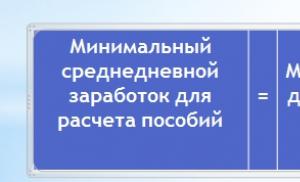Transfer of child benefits in November. What is the amount of benefits for birth, child care, pregnancy and childbirth?
In conditions of an acute shortage of budget funds due to the difficult economic situation in the country, the Government of the Russian Federation was forced at the end of 2015 to make a number of decisions aimed at cost reduction federal budget for social expenditure items:
- do not perform traditional indexing child benefits from January 1, 2016 and other social payments to families with children, and limited to their pre-indexation from February 1 to the amount of inflation for the previous year;
- completely eliminate indexation for at least one year maternity capital in 2016, taking its size at the level of 2015;
- apply targeting criteria and principles of need in the regions of the Russian Federation, which will reduce the number of recipients regional payments per child.
In fact, these changes mean the beginning of a new social reform in relation to families with children who receive various measures of material support from the state.
Indexation of child benefits
First of all, families with children are concerned about the issue of increasing the amount of child benefits - i.e. Will they increase due to indexation?
- Indexation of child benefits to the amount of projected inflation (i.e. "at a faster pace") annually from January 1 was first introduced back in 2008. However, one of the measures taken in 2015 by the Government to reduce the country’s budget deficit was the suspension in 2016 of the current procedure for indexing social benefits.
- Instead, from February 1, 2016, child benefits will be indexed according to actual (last year’s) inflation (i.e. "catching up") regarding the amount of child benefits that were established from January 1, 2015.
Amount of child benefits in 2016
In 2015, child benefits were indexed to an underestimated inflation rate - by 5,5% and then the indexation coefficient was 1.055. But actual inflation for the year amounted to 12,9% , i.e. the indexation coefficient should have been 1.129.
In accordance with this, from February 1, an additional indexation of benefits by 7% will be carried out:
1.129 / 1.055 = 1.070, or 7.0%.
Taking this coefficient into account, you can create a table of child benefits in 2016.
Table of child benefits in 2016
| Title of the manual | Amount of payments, rub. | |
|---|---|---|
| from January 1, 2016 | from February 1, 2016 | |
| One-time payments | ||
| Benefits for women when registering in the early stages of pregnancy | 543,67 | 581,73 |
| Maternity benefit for pregnancy and childbirth | 100% of average earnings for the previous 2 years, at the minimum wage or at a minimum fixed amount: | |
| 543,67 | 581,73 | |
| Maternity benefits for conscript wives | 22958,78 | 24565,89 |
| One-time benefit for the birth of a child | 14497,80 | 15512,65 |
| Child benefits for adoption, guardianship and foster care | 14497.80 or 110775* | 15512.65 or 118529.25* |
| * An increased payment is made when adopting a disabled child, a child over 7 years old, or several children who are brothers or sisters (for each) | ||
| Maternity capital | 453026 | 453026 (does not increase) |
| Monthly payments | ||
| Child care allowance | 40% of the average monthly earnings for the previous 2 years per child or the minimum amount: | |
|
|
|
| Childcare benefits for conscripts | 9839,48 | 10528,24 |
| Payment to families with many children for the third and subsequent children under 3 years of age | In the amount of the established regional subsistence minimum for a child | |
| Survivor's benefit for a child of a military personnel | 1978,97 | 2117,50 |
Amount of maternity payments in 2016
During pregnancy and after childbirth, the state supports parents with material payments in the form of monthly and one-time child benefits.
This type of support is provided:
- employed women if you have insurance experience - in the form of compulsory social insurance in proportion to average earnings;
- idle- in the minimum established amount in the form of state social security (through Social Security).
When going on maternity leave, women in Russia can count on receiving the following payments:
- Maternity benefit (M&B)- calculated depending on the number of days of absence from work indicated on the sick leave:
- for 140 days - minimum RUB 28,555.40;
- for 156 days - minimum RUB 31,818.87;
- for 194 days - minimum RUB 39,569.62
- Additional allowance for maternity benefits when registering for pregnancy in a antenatal clinic up to 12 obstetric weeks - it is set in a fixed amount ( RUB 581.73 from February 1).
- One-time benefit for the birth of a child, which is also set in a fixed amount ( RUB 15,512.65 from February 1).
- Child care allowance up to 1.5 years old, paid monthly and calculated as a percentage of the mother’s average salary before going on maternity leave, but not less than:
- 2908.62 - for the first child;
- 5817.24 - for the second and subsequent ones.
Below is more detailed information about maternity payments for BiR and for child care up to 1.5 years.
Maternity benefit
During pregnancy, a working woman is required to take maternity leave, for which benefits are paid. The legislation of the Russian Federation provides several options for its duration(depending on the severity of labor and the number of children born):
- at birth 1 child:
- for uncomplicated childbirth - 140 days of leave (70 days before and 70 after childbirth);
- in case of complicated childbirth - with postpartum leave extended to 86 days (156 days in total);
- at birth 2, 3 or more children- 194 days of vacation (84 days before and after childbirth, 110 days).
These days will be paid to working women in the amount of 100% of average earnings for the last 2 full years (by multiplying the average daily earnings by the corresponding number of days).
In this case:
- Minimum size benefits cannot be lower than the minimum wage(the minimum wage, which in 2016 is 6204 rubles) per 1 month (see above).
- Maximum size payments in 2016 will not exceed:
- for 140 days - 248,164.38 rubles;
- for 156 days - 276,526.03 rubles;
- for 194 days - 343884.93 rubles.
Child care allowance
After the birth of a child, the mother has the right to receive a monthly child care benefit for up to 1.5 years.
This payment is provided not only employed mothers, but also non-working women, as well as the child’s father or other relatives who are actually caring for him.
The amount of this payment is set as follows:
- for working women- from the employer or from the Social Insurance Fund (SIF):
- is calculated by multiplying 40% of the average earnings for the 2 previous years by 30.4 (i.e., by the average number of days per month for 12 months) and multiplied by a factor of 0.4.
- for non-working mothers- through the Social Security authorities (Sobes):
- in the minimum amount, which from February 1, 2016, taking into account indexation, is 2908.62 rubles. for the first child or 5,817.24 rubles. on the second and subsequent ones.
After the child reaches the age of 1.5 years, there is no additional assistance for families with children, except for a monthly compensation in the amount 50 rubles from the employer, not provided.
Amount of maternity capital in 2016
In accordance with the laws signed by V.V. Putin in December 2015, the maternity capital program will be extended until December 31, 2018, however, its size in 2016 will not be indexed and will remain at the level 453 thousand 026 rubles.
It is noted that the decision not to carry out maternity capital indexation in 2016 is just one-time pass, which is caused by a lack of funds in the federal budget. It will be restored starting in 2017 and will be indexed every subsequent year in the usual manner:
- in 2017- approximately 6% to 480 thousand rubles;
- in 2018- by another 5%, which will be 505 thousand rubles.
Changes in 2016 and latest news
In fact, since 2016, Russia has been implementing a new social reform, which was adopted due to the existing state budget deficit. Shortly before this, during working meetings of the Government, Dmitry Medvedev gave instructions when forming the federal budget for 2016 proceed from such requirements:
- reduce costs state budget for 2016-2018;
- take into account the need carrying out indexation basic social payments;
- provision of benefits and benefits based on principle of targeting And need criteria.
In this regard, as mentioned above:
- the amount of maternal (family) capital as of 2016 will remain at the level of 2015, and will be indexed only from 2017.
- from February 1, 2016, a new procedure for indexing child benefits and other social payments is being established - now they will increase annually according to actual inflation for the past year, that is "catching up", not "advanced", like almost a whole decade before.
- when determining the amount of maternity benefits for the mother, income for the previous two years - 2014 and 2015 - must be taken into account, which will be taken into account in increasing the maximum possible amount of benefits for working women.
Conclusion
In 2016, a large number of changes occurred related to the current state of the Russian economy, and the Government of the Russian Federation is taking all kinds of decisions to stabilize it.
Some decisions have a negative impact on the condition of families with children, and even more so on the condition of large families: benefits and other social payments for the child are not properly indexed; in 2016, the amount of maternity capital will remain at the same level (453,026 rubles), and payments will be more difficult to obtain, since the circle of people who were previously entitled to them will be narrowed due to the introduction of a need criterion.
Let’s hope that all government reforms will help us return to the previous economic level, and families in need will once again become more socially protected.
From July 1, 2016, the minimum wage increased to 7,500 rubles. (Cm. " "). In this regard, from July 1, there were changes in the calculation of some benefits. How to count benefits from July 1, 2016? Which amount of child benefits from July 1, 2016? Has the amount of child care benefit changed? How much will the Social Insurance Fund reimburse benefits from July 1? You will find answers to these and other questions related to benefits in our article.
Introductory information
New minimum wage
Sickness, maternity and child benefits, in general, should be calculated from the average earnings for the billing period, that is, for the two years preceding the onset of illness, maternity leave or vacation of the year (from January 1 to December 31). Accordingly, if an employee, say, fell ill in July 2016, then the billing period will be 2014 and 2015 (Part 1, Article 14 of Federal Law No. 255-FZ of December 29, 2006).
However, earnings for the billing period should not be less than a certain amount. The state guarantees the calculation of benefits based on the minimum allowable earnings. It is defined like this:
Accordingly, if an insured event (illness, maternity leave or parental leave) occurred after July 1, 2016, then the minimum earnings for the billing period will be 180,000 rubles. (RUB 7,500 × 24 months).
To find out the minimum average daily earnings for calculating benefits, the accountant needs to divide the resulting value by 730. The following formula is used:

Accordingly, from July 1, 2016, the minimum average daily earnings is 246.58 rubles per day (180,000 rubles / 730 days). From July 1, 2016, the average daily earnings for calculating benefits cannot be less than this value.
Before July 1, the average daily earnings were 203.97 rubles (6,204 rubles × 24 months / 730). That is, the average daily earnings increased by 42.61 rubles (246.58 rubles – 203.97 rubles).
Earning less than minimum
The accountant of an organization or individual entrepreneur should ensure that employee benefits are calculated correctly. This will allow you to receive a refund without any problems. benefits from the Social Insurance Fund and after July 1, 2016. Let us explain what to pay attention to.
So, let’s assume that the insured event (illness, maternity leave or the start of parental leave) occurred in July 2016. The calculation period will be 2014-2015. To calculate the benefit, the accountant needs to determine the average daily earnings using the following formula:

When calculating temporary disability benefits, the number of days should be substituted into this formula - 730. If you are calculating maternity or child care benefits, then the number of days may be less, since days of illness, maternity leave, child leave and release from work are excluded from the calculation period with preservation of earnings (clauses 3 and 3.1 of Article 14 of the Federal Law of December 29, 2006 No. 255-FZ).
Based on the results of this calculation, the average daily earnings cannot be less than the amount calculated from the minimum wage. That is, from July 1, 2016, the average daily earnings cannot be less than 246.58 rubles per day.
Keep in mind that when determining the minimum average daily earnings, you must take into account the minimum wage on the date of the insured event. Accordingly, if an employee gets sick or if an employee went on maternity leave before July 1, 2016, then use the minimum wage in the amount of 6,204 rubles in the calculation. In this case, the minimum amount of daily earnings will be 203.97 rubles. (6204 × 24 months / 730 days). If the insured event occurred on July 1 or later, then focus on the “minimum wage” of 246.58 rubles. (RUB 7,500 × 24 months / 730 days).

An example of calculating sickness benefits from the minimum wage.
I.A. Feoktistova was ill from July 19 to July 27, 2016 (9 calendar days). Her insurance experience is 2 years and 3 months. The amount of payments in her favor for the billing period (2014 and 2015) amounted to 158,650 rubles.
Under such conditions, the actual average daily earnings of I.A. Feoktistova is equal to 217.33 rubles. (RUB 158,650/730).
However, the average daily earnings, calculated from the minimum wage, is 246.58 rubles. (RUB 7,500 × 24 months / 730). This amount is higher than I.A.’s actual earnings. Feoktistova: 246.58 rubles. > 217.33 rub. Therefore, to calculate sickness benefits, the accountant should take the value calculated based on the minimum wage.
Since the experience of I.A. Feoktistova is less than 5 years old, the amount of her benefit will be 60% of average earnings (clause 3, part 1, article 7 of the Federal Law of December 29, 2006 No. 255-FZ).
As a result, the amount of sickness benefit will be 1331.53 rubles. (RUB 246.58 × 60% × 9 days).
So, using an example, you can trace increase in benefits from July 1, 2016. After all, if the minimum wage had not been increased, then the accountant would have to use the average daily earnings of 203.97 rubles as the average daily earnings.
Please note: if there is a regional coefficient in your area, multiply the minimum benefit calculated from the minimum wage by it. That is, if in the area where I.A. is occupied. Feoktistov’s coefficient was set at, say, 1.7, then the amount of benefits due to her would be 2263.60 rubles. (RUB 246.58 × 60% × 9 days × 1.7).
There is no earnings in the billing period
If the employee has no earnings at all during the billing period, then to calculate the benefit, instead of zero, one should also take the earnings calculated by the minimum wage, which was established at the time of the insured event. This situation can occur if the employee did not work at all during the pay period and does not have the right to replace the years of the pay period. Let us give examples of such calculations.
Sickness benefit: example of calculation after July 1
A.S. Ivanov was sick from July 4 to July 12, 2016 (that is, 9 calendar days). He had no earnings in the billing period (2014-2015). Experience – 5 years and 2 months. A.S. Ivanov works full time.
In such a situation, the accountant should take the average daily earnings calculated from the minimum wage, namely 246.58 rubles. (RUB 7,500 × 24 months / 730)
Experience A.S. Ivanov for more than 5 years. This means that he is entitled to 80 percent of average earnings (Clause 2, Part 1, Article 7 of Federal Law No. 255-FZ of December 29, 2006). Therefore, the daily allowance will be 197.26 rubles. (RUB 246.58 × 80%).
A.S. Ivanov was sick for 9 days. During this period, the amount of benefits due to him will be 1775.38 (197.26 rubles × 9 days).
We will also give an example of calculating maternity benefits in a situation where there was no earnings in the billing period.
Maternity benefit: example of calculation after July 1
S.B. Nikolaeva wishes to go on maternity leave from July 28, 2016. The billing period is from January 1, 2014 to December 31, 2015. There was no earnings during the billing period. Insurance experience - 7 months. The regional coefficient does not apply.
The minimum average daily earnings is 246.58 rubles. (RUB 7,500 × 24 months) / 730. Daily allowance - RUB 246.58. (RUB 246.58 × 100%). As a result, the amount of S.B.’s benefit Nikolaeva for 140 calendar days of maternity leave, calculated from the minimum wage, will be 34,521.2 rubles. (RUB 246.58 × 140 days).
Please note: An employee who is assigned sickness benefits, maternity benefits or child care benefits has the right to contact the accounting department and ask to replace one or both years of the billing period with other years. To do this, she will need to write a statement. In this case, the accountant will have to replace the years while simultaneously meeting 3 conditions:
- a woman wants to change the years in which she was on maternity leave or parental leave;
- the years selected for replacement precede the billing period (letter of the Ministry of Labor of Russia dated August 3, 2015 No. 17-1/OOG-1105);
- As a result of changing years, the benefit amount will become larger.
Thus, before calculating benefits from the minimum wage, it makes sense for an accountant to check whether the employee has the right to replace the years of the calculation period.
Less than six months experience
Benefits for temporary disability and pregnancy and childbirth cannot exceed the minimum wage for a calendar month (taking into account regional coefficients), if the person’s length of service is no more than six months (Part 6, Article 7, Part 3, Article 11 of the Federal Law of December 29, 2006 No. 255-FZ). That is, with less than six months of experience, the benefit may be less, but not more than the minimum wage. To control this, you need to calculate the maximum daily allowance in each month (to understand what amount cannot be taken into account in the calculations). To do this, use the following formula (clause 20 of the Regulations on the calculation of benefits, approved by Decree of the Government of the Russian Federation of June 15, 2007 No. 375):

Accordingly, if we are talking, say, about illness in July, then the maximum daily benefit in this month will be 241.94 (7500 rubles / 31 days), since July 2016 has 31 calendar days.
Let's explain the calculations with an example.
An example of calculating disability benefits for less than six months of work experience.
M.V. Trugmanov was ill from July 11 to July 28, 2016 (18 calendar days). The employee's length of service is less than six months. In the billing period (2014-2015), there are no payments in favor of the employee (this is his first place of work).
As we have already found out, the average daily earnings, based on the minimum wage, from July 1, 2016 is 246.58 rubles. (RUB 7,500 × 24 months / 730). Moreover, if the insurance period is up to five years, then when calculating sickness benefits, 60% of average earnings should be taken into account (clause 3, part 1, article 7 of the Federal Law of December 29, 2006 No. 255-FZ). Therefore, the amount of M.V.’s daily allowance Trugmanov will be 147.95 rubles. (RUB 246.58 × 60%). As a result, for 18 calendar days of illness, the benefit amount will be 2663.10 rubles. (147.95 × 18 days).
Now let's check whether this amount is overestimated. To do this, let’s take the maximum amount of daily benefits in July, calculated from the minimum wage, that is, 241.94 (7,500 rubles / 31 days). If we take this amount, then for 18 days of illness the maximum benefit will be 4345.20 rubles. (RUB 241.94 × 18 days). We no longer take into account the employee's length of service.
4345.20 rubles more than 2663.10 rubles. This means that for July M.V. Trugmanov needs to pay a smaller amount - 2663.10 rubles. The maximum value is not exceeded.
We will also provide the calculation of maternity benefits for less than six months of service.
An example of calculating maternity benefits for less than 6 months of service.
L.S. Sadovskaya has been going on maternity leave since June 21, 2016. It will end on November 8, 2016. In the billing period from January 1, 2014 to December 31, 2015, she has no income. Insurance experience - 5 months and 1 day. The regional coefficient does not apply.
Let's determine the average daily earnings from the minimum wage, which was applied at the beginning of maternity leave (that is, in June). The average daily earnings will be 203.97 rubles. (RUB 6,204 × 24 months / 730 days). Accordingly, the daily allowance will be 203.97 rubles. (RUB 203.97 × 100%).
The maximum daily benefit depending on the number of calendar days is as follows:
- in June – 206.80 rubles. (6204 rubles / 30 calendar days);
- July, August and October – 241.94 rubles. (RUB 7,500 / 31 calendar days);
- September and November – 250 rub. (7500 rubles / 30 calendar days).
Now let’s compare the amount of the daily allowance from the minimum wage with the maximum daily allowance for each month of maternity leave. And it turns out that the daily allowance from the minimum wage does not exceed the maximum daily allowance in all months of maternity leave:
- RUR 203.97< 206,80 руб.;
- RUR 203.97< 241,94 руб.;
- RUR 203.97< 250 руб.
Thus, the accountant has the right to calculate the allowance from the daily allowance calculated from the minimum wage - 203.97 rubles. As a result, the amount of benefit to L.S. Sadovskaya for 140 calendar days of maternity leave will be 28,555.8 rubles. (RUB 203.97 × 140 days), where 140 days is the duration of maternity leave.
Violation of hospital regulations
The employer has the right to limit the amount of sick pay for a full calendar month to the minimum wage if the employee, without good reason (Part 1, Article 8 of Federal Law No. 255-FZ of December 29, 2006):
- violated the hospital regime - from the day the violation was committed;
- did not show up for an appointment with a doctor or for a medical and social examination - from the day of failure to appear;
- fell ill or was injured due to alcohol, drug, or toxic intoxication - for the entire period of incapacity.
Let us explain how you can limit the amount of benefits using the minimum wage.
An example of limiting sickness benefits in case of violation of the regime.
A.G. Petrov brought a certificate of incapacity for work to the accounting department for the period of illness from July 11 to July 28, 2016. However, the sick leave note contains a note about violation of the regime on July 18 (the employee did not show up for an appointment with the doctor for an unexcused reason).
In such a situation, sick leave benefits until July 18 must be calculated according to general rules, based on their average earnings. And from July 18 to July 28 (that is, 10 days from the date of violation), benefits can be paid based on the minimum wage. In the region where A.G. works Petrov, the regional coefficient has not been established. His insurance experience is eight years. This means that he is entitled to a benefit in the amount of 100 percent of his earnings (Part 1, Article 7 of Federal Law No. 255-FZ of December 29, 2006).
The maximum average daily earnings for July, calculated from the minimum wage, will be 241.94 rubles. (RUB 7,500/31 days)
The benefit amount for July 18–28 (that is, for the period of violation of the regime) will be: 2,419.40 rubles. (RUB 241.94 × 10 days). Before the date of violation, benefits can be calculated according to general rules (not from the minimum wage).
New minimum amount of child care benefit
Now let's talk about the increase child benefits from July 1, 2016. So, let us recall that the employer must pay child care benefits to the employee monthly in an amount equal to 40% of average earnings, but not less than the minimum amount (Clause 1, Article 11.2 of the Federal Law of December 29, 2006 No. 255-FZ). From February 1, 2016, the minimum child care benefits are as follows:
- 2908.62 rubles – for the first child;
- 5817.24 rubles – for the second and subsequent children (Resolution of the Government of the Russian Federation dated January 28, 2016 No. 42).
However, due to the increase in the minimum wage, the minimum size child benefits from July 1, 2016, established on February 1, does not apply from July 1, 2016 (for the first child). The fact is that until July 1, the minimum wage had no effect on the minimum child benefit. When the minimum wage was 6,204 rubles, it was pointless to calculate benefits based on this amount - it turned out to be less than 2,908.62 rubles. (6204 × 40% = 2481.60). However, since July 1, 2016, the situation has changed. Minimum amount of benefit for caring for the first child from July 1, 2016 is 3000 rub. (RUB 7,500 × 40%). However, you can only use the new value if the vacation began on July 1, 2016 or later. At the same time, the “minimum wage” for caring for the second and subsequent children has not changed. It remains 5817.24 rubles even after July 1st.
Amounts of other benefits
An increase in the minimum wage will not affect the size unemployment benefits from July 1, 2016. The fact is that the amount of this benefit is limited to the maximum (4,900 rubles) and minimum (850 rubles + regional coefficient, if established) amount. These amounts for 2016 are determined by Decree of the Government of the Russian Federation dated November 12, 2015 No. 1223 “On the amounts of the minimum and maximum amounts of unemployment benefits for 2016.” In this regard, despite the fact that from July 1 the minimum wage increased to 7,500 rubles, unemployment benefits still cannot be more than 4,900.
The amount of some other types of benefits will also not change in any way due to the increase in the minimum wage. So, for example, the lump sum benefit for the birth of a child will not change from July 1. Its size will remain at 15,512.65 rubles.
In the table below we have summarized the values associated with benefits. In the table, in particular, you can see changes in the calculation of child benefits from July 1.
Table. Values associated with benefits from February 1 and July 1, 2016
| Benefit | From February 1, 2016 | From July 1, 2017 |
| Maximum monthly child care benefit | RUB 21,554.82 | RUB 21,554.82 |
| Minimum amount of maternity benefit | RUB 28,555.40 (for multiple pregnancy - 39,569.62 rubles, complicated childbirth - 31,818.87 rubles). | RUB 34,521.20 (for multiple pregnancy - 47,835.62 rubles, complicated childbirth - 38,465.75 rubles). |
| Maximum amount of maternity benefit | RUB 248,164 (for multiple pregnancy - 343,884.4 rubles, complicated childbirth - 276,525.6 rubles) | |
| Maximum average daily earnings for calculating benefits | 1772.6 rub. | 1772.6 rub. |
| Calculation period for calculating disability benefits | 2014-2015 | 2014-2015 |
| One-time benefit for the birth of a child | RUB 15,512.65 (with indexation from February 1 7%) | RUB 15,512.65 |
| Benefit for registration in early pregnancy | RUB 581.73 (with indexation from February 1 7%) | RUB 581.73 |
| Minimum amount of benefit for child care up to one and a half years old | For the first child - 2908.62 rubles; Care for the second child RUB 5,817.24. (with indexation from February 1 7%) | For the first child - 3000 rubles; Care for the second child RUB 5,817.24. |
New participants in the pilot project
New figures: table
In conclusion, we have summarized the most important figures that have changed due to the increase in the minimum wage and the calculation of benefits reimbursed from the Social Insurance Fund. This table will help consolidate information about increase in benefits from July 1 2016.

January 1, 2016 can actually be considered the start date of a major social reform. Its need has been brewing for a long time, but today, in the new economic conditions, and taking into account the very real possibility of a long-term crisis, it is needed more than ever.
Approaches to organizing material support for families raising children have developed in the absence of a budget deficit and today include several types of payments. These include:
- Federal benefits:
- paid to citizens with children under compulsory social insurance, in accordance with Law No. 255-FZ of December 29, 2006 at their place of work or directly from the Social Insurance Fund;
- paid by Social Security authorities at the place of residence of citizens with children from the federal budget, under the state social security program (in accordance with the requirements of Law No. 81-FZ 05/19/1995).
- Federal maternity capital, which since 2007 has been provided from the Pension Fund of the Russian Federation at the birth or adoption of the second and subsequent children (according to Law No. 256-FZ of December 29, 2006).
- Matkapital and regional children's benefits. They are paid from local budgets of different subjects of the federation and are regulated by:
- recommendations and requirements of federal laws mentioned above;
- “May decrees” of the President of the Russian Federation V. Putin;
- numerous republican, regional, regional and city decrees and resolutions establishing measures and ways of material support for a certain category of citizens or individual families.
How will social reform affect child benefits?
Until the beginning of 2016, child benefits gradually increased and were necessarily indexed in the event of a decrease in the purchasing power of the ruble.
For example, in 2015:
- the amount of maternity capital increased by 29 thousand rubles from 429,408.5 to 453 thousand 26 rubles;
- the one-time benefit, which is paid to women registering for medical treatment up to 12 weeks, increased from 515.33 to 543.67 rubles;
- maternity benefits were increased from 25,564 rubles to 27,455;
- the one-time benefit to the wives of military personnel on active duty increased by 5.5%;
- The lump sum payment at the birth of a child increased by 800 rubles.
But it is difficult for the budget to cope with such a growing load, therefore, in May 2015, Dmitry Medvedev, following the results of working meetings, instructed the relevant ministries to plan the budget for the next year, including two main requirements. By the way, the requirements turned out to be very contradictory:
- Reduce the budget deficit by reducing “ineffective costs”;
- Index social payments to citizens in accordance with the laws, decrees and regulations mentioned above.

The most effective and “painless” way for people to achieve their goals is to transfer social payments to the principles of need and targeting. Namely, to provide assistance not to everyone, but only to those who really need it.
To achieve the set goals, several unpopular decisions were made in December 2015:
- Limit the number of recipients of child benefits and benefits by using targeting and need criteria (Law No. 388-FZ of December 29, 2015);
- Abandon the annual advanced indexation of child benefits and all other social payments for 2016 from January 1, limiting ourselves to only pre-indexation for 2015 (No. 371-FZ dated December 14, 2015);
- Completely abandon any indexation of maternity capital, leaving it at last year’s level - 453,026 rubles (budget law No. 359-FZ of December 14, 2015).
Indexation of child benefits in 2016
Many mothers were wary of the changes in the indexation procedure for child benefits, fearing their complete abolition. In fact, nothing bad happened.
Let us recall that annual, so-called “advanced” indexation was introduced only in 2008. Then it was decided to increase all payments from January 1 of this year, taking into account the projected inflation and rising consumer prices.
In today's conditions of the economic crisis, frequent jumps in currency prices and falling oil prices, it is almost impossible to predict the level of inflation for a whole year in advance. Therefore, it was decided to do indexation not at the beginning of the year, almost at random, but at the end, when there will already be accurate data on the amount of inflation.
Of course, such a step will negatively affect the well-being of families with children. But this will allow the state to significantly save resources until February 2017. But at the same time, benefits for 2015 will have to be indexed in February 2016. This is due to the fact that advanced indexation was carried out based on an inflation rate of 5.5%. But in 2015 it amounted to 12.9%, that is, it was more than twice as much as planned.
Amounts of child benefits in 2016
It can be very difficult for an ordinary young mother to understand the size of social benefits, given all the changes that have occurred recently. Therefore, we will compile a special table.
Indexation of child benefits 20016
Title of the manual | Size from 02/01/2016 (rubles) | Note |
One-time payments |
||
Benefit for early registration in the housing complex (up to 12 weeks of pregnancy) | Carried out simultaneously with maternity benefits, a corresponding medical certificate is required to receive |
|
Maternity benefit | 100% of average earnings for the previous 2 years or according to the minimum wage 581.73 rubles in the amount of scholarship | Accrued for the entire period of maternity leave at a time in proportion to its duration (140, 156 or 194 days) In case of liquidation of the organization - in a fixed minimum amount Students receive scholarships at their place of study |
Benefit for the pregnant wife of a conscript soldier | 24565,89 | Paid to the wife of a serviceman on compulsory military service with an obstetric gestation period of at least 180 days (third trimester) |
One-time benefit for the birth of a child | 15512,65 | It can be obtained both at the place of work, in the form of social insurance, and in the form of state social security in the social protection authorities. The right to receive payments belongs to any of the parents, or to the person replacing them |
Benefit for placing a child in a family (adoption, establishment of guardianship and trusteeship, placing a child in a foster family) | 15512,65 118529,25 | Increased benefits are paid to people who adopt:
|
Monthly payments |
||
Child care allowance | 40% of average earnings for the previous 2 years, but not less:
| Accrued at the place of work (service) in the form of social insurance for those on parental leave and paid together with wages or cash allowance Unemployed people can receive the minimum amount in the form of state social security for the unemployed in the USZN at their place of residence |
Allowance for a child of a conscript up to 3 years of age | 10528,24 | The right to receive payment arises from the birth of the child, but not earlier than the beginning of his father’s compulsory military service. The benefit is provided until the child reaches three years of age, but not until his father completes his military service. |
Survivor benefits for military children | Provided by the pension authorities of the Ministry of Defense of the Russian Federation or by the USZN at the place of residence along with a survivor’s pension |
|
Monthly payment for the third child and subsequent children under 3 years of age | In the amount of the regional subsistence minimum per child | As of 1.01. 2016 is paid in 69 constituent entities of the Russian Federation in accordance with order No. 1354-r dated July 26, 2012. (http://government.ru/docs/4428/) |
Maternity capital in 2016
Ideas about abandoning the indexation of maternity capital began to appear back in 2015, when it became clear that it was unrealistic to predict an increase in inflation. As a result, the State Duma adopted laws No. 359-FZ and No. 371-FZ dated December 14, 2015, limiting indexation in 2026.

Therefore, the amount of maternity capital will not change. But this is a temporary limitation; starting from 2017, indexation will be carried out again. Thus, in January 2017, maternity capital will increase by 6% and amount to 480 thousand rubles, and in January 2018 by another 5% and amount to 505 thousand rubles.
The government is well aware that the actual depreciation of maternity capital due to high inflation may occur much sooner than predicted. Therefore, as some compensation, a significant expansion of the areas of use of certificates is planned. This will enable parents to quickly use their capital without waiting for it to depreciate. As of January 1, 2016, maternity capital can be spent on purchasing services and technical equipment necessary for the rehabilitation of disabled children. A little later, it will be possible to use this certificate to pay for the services of individual entrepreneurs, for example, private kindergartens or nannies.
The maternity capital program has been implemented for 10 years. During this time, its amount increased by 81% (from 250 to 453 thousand rubles). Annual indexation averaged 8.1%.
What does “transition to the principles of targeting and need” mean and how will this affect benefits?
Social reform and the transition to new principles for calculating child benefits gives young mothers fear. And for good reason, because “reducing ineffective payments” in any case implies a reduction in their volumes. What should we expect?
The payment system, which worked until recently, dates back to the USSR and is guided by the principles of relative equality, when most people receive the same benefits. But given the lack of budget money, it becomes too much of a burden for the country. In such a situation, it is worth reducing payments and making it as painless as possible for the people. One of these methods is the provision of targeted assistance. This will make it possible to identify families who really need state support and to send financial assistance to them, while reducing costs by limiting payments to wealthier segments of the population.
One of the main problems that the creators of social reform faced was what criteria to use to identify families in need. So far, the Government has failed to develop clear and fair criteria for “need” that would make payments truly targeted and fair. To do this, it is necessary to think over a system that will make it possible to set the size of payments for each specific family, and not for entire categories of the country’s population.
One of the most suitable criteria for identifying families in need is the average income per family member. If it is less than the officially recognized subsistence level, such a family can be recognized as needy and provided with material support in the appropriate amount.
But this method is far from ideal. The opportunity to receive social assistance from the state when the level of income decreases may lead to a desire to deliberately reduce it. This can be done in several ways:
- Work less;
- Hide part of the profits from the state;
- Through a fictitious divorce from the spouse who earns the bulk of the family budget.
And if facts of concealing profits and tax evasion can be identified, then other methods of reducing income are almost impossible to stop. Therefore, a reduction in social spending due to the transition to the principles of targeting and need in the future may again lead to their growth due to an increase in the number of “needy” families. In addition, such a policy may negatively affect the filling of extra-budgetary government funds, such as the Social Insurance Fund, the Pension Fund and the Compulsory Medical Insurance Fund.
One of the most negative consequences of hiding income is a decrease in the number of pension contributions. If we take into account the changes associated with the pension reform that came into force in 2015, such concealment of profits could lead to a real social catastrophe - the vast majority of pensioners will fall below the poverty line.
It should be noted that the Ministry of Labor has repeatedly confirmed that a number of payments existing today cannot be provided taking into account the criterion of need. For example, maternity capital, the terms of which are not limited by law, cannot be paid in any format other than the one already in use. Indeed, need can only be determined in a certain period of time, for example, over the past six months, and a family can apply for the disposal of its maternity capital 5 or 15 years after the birth of the child.
Therefore, at the moment, the Ministry of Labor recognizes that the principles of need can only be introduced when calculating a number of regional payments. At the same time, the load on local social security authorities will increase, which may require staff expansion.
Child care benefit in 2016
One should not think that the only purpose of introducing targeting principles is to narrow the circle of recipients of social support. In fact, it will also allow the introduction of new types of benefits that will be intended for specific recipients, for which additional requirements may also be established.
Dmitry Medvedev, at the All-Russian Forum of Social Workers, held on March 27, 2015, called on the Government to take up the issue of extending child care benefits from one and a half to three years. But it should only concern those families for whom this is relevant. After all, for most mothers, payments are not so important as the opportunity to resume working activities after the baby reaches 1.5 years.
To date, the extension of child care payments has not yet been implemented. To do this, it is necessary to solve several important problems:
- will determine and clearly formulate the criteria of need according to which the extension of payments will be carried out;
- based on the criteria received, compile a register of potential benefit recipients;
- find sources to finance assistance to all identified families in need, and do this without increasing the burden on the federal budget, but by attracting funds from other sources, for example, by attracting the resources of employers;
- find methods to effectively stimulate parents’ early exit from parental leave to care for a child under 3 years of age;
- change labor laws to allow for greater use of flexible work schedules and part-time employment.
- find opportunities to open a large number of nursery groups of kindergartens in the shortest possible time.
At the moment, all these issues have not yet been resolved, so many parents cannot take parental leave because there are not enough places in nursery groups in kindergartens. And while on vacation, they can only claim a monthly compensation from the employer in the amount of 50 rubles.
As part of the search for a solution to this problem, Dmitry Medvedev instructed the Russian Ministry of Labor, together with the Ministry of Economic Development and the Ministry of Education and Science, to study the issue of extending child care payments up to 3 years by July 1, 2015 if:
- income per family member is below the regional subsistence level;
- At the moment, there are no free places in the nursery groups of kindergartens or parents cannot find a job at their place of work with a flexible schedule.
Based on the results of a thorough study of the issue, it turned out that to implement this proposal, 50 billion rubles will be required for 2016 alone. from the budget. In modern crisis conditions, such an amount is an exorbitant burden for the country.
How to apply for child benefits in 2016 in the Russian Federation
Receiving any type of social assistance may involve collecting documents and certificates. They are necessary to confirm the fact that this family really has the right to government support. The list of documents differs in each individual case, so young parents often get confused about what exactly they need. In addition, the list may gradually change. This is also related to social reform.
How to receive a lump sum benefit upon the birth of a child?
The amount of this benefit is fixed and is due at birth to all children whose parents are Russian citizens. As mentioned earlier, at the beginning of 2016 it will not be indexed. The benefit increase will be carried out at the end of the year.
Payment of this benefit is carried out at the expense of the Federal State Insurance Fund. In the event of the birth of twins or triplets, it is paid double or triple the amount, respectively.
Employed parents receive it at their place of work, and for unemployed parents the fund transfers it to their account. To receive money, parents must consider three parameters:
- The main condition for receiving such benefits is Russian citizenship. If a child was born on Russian territory, but his parents are foreigners or stateless persons, they will not be able to receive money.
- To receive it, you must confirm the fact of the baby’s birth using a certificate issued by the registry office.
- You can apply for a one-time benefit within six months after the birth of the child. During this period, the certificate issued to the parents at the maternity hospital is valid.
To simplify the procedure for applying for benefits for young mothers who do not have time to visit various government institutions, the electronic government has provided the opportunity to do this through the State Services portal without leaving home. It's very easy to do. First you need to register and go to the website.https://www.gosuslugi.ru/ , then go through a simple registration procedure and select the desired service. The site will ask you to fill out an application, on the basis of which the benefit will be issued. The site’s interface is very easy to use and understandable even to the least confident Internet users, so the procedure usually does not cause any difficulties.
To receive social benefits, a working parent can contact the accounting department or human resources department at the enterprise with a corresponding application addressed to the director and a package of documents, which includes:
- copy and original documents confirming birth;
- a document confirming the conclusion or divorce of a marriage;
- certificate of family composition;
- confirmation that the second parent has not exercised his right to benefits elsewhere.
Within 10 days after submitting the documents, the company is obliged to pay the money.
Non-working parents apply for benefits to the OSZN authorities. The list of documents for them is different:
- passport - original and photocopy;
- documents confirming the conclusion or divorce of marriage;
- KSM certificate;
- if parents have work records, it is necessary to bring originals and photocopies of all pages; if they do not exist, documents on education;
- if the parents are entrepreneurs - a certificate of individual entrepreneur;
- if the residential address differs from the registration, you will need a certificate from the OSZN stating that benefits were not accrued at another address;
- if there is only one parent, you must bring Form 25;
- Parents' bank account information.













